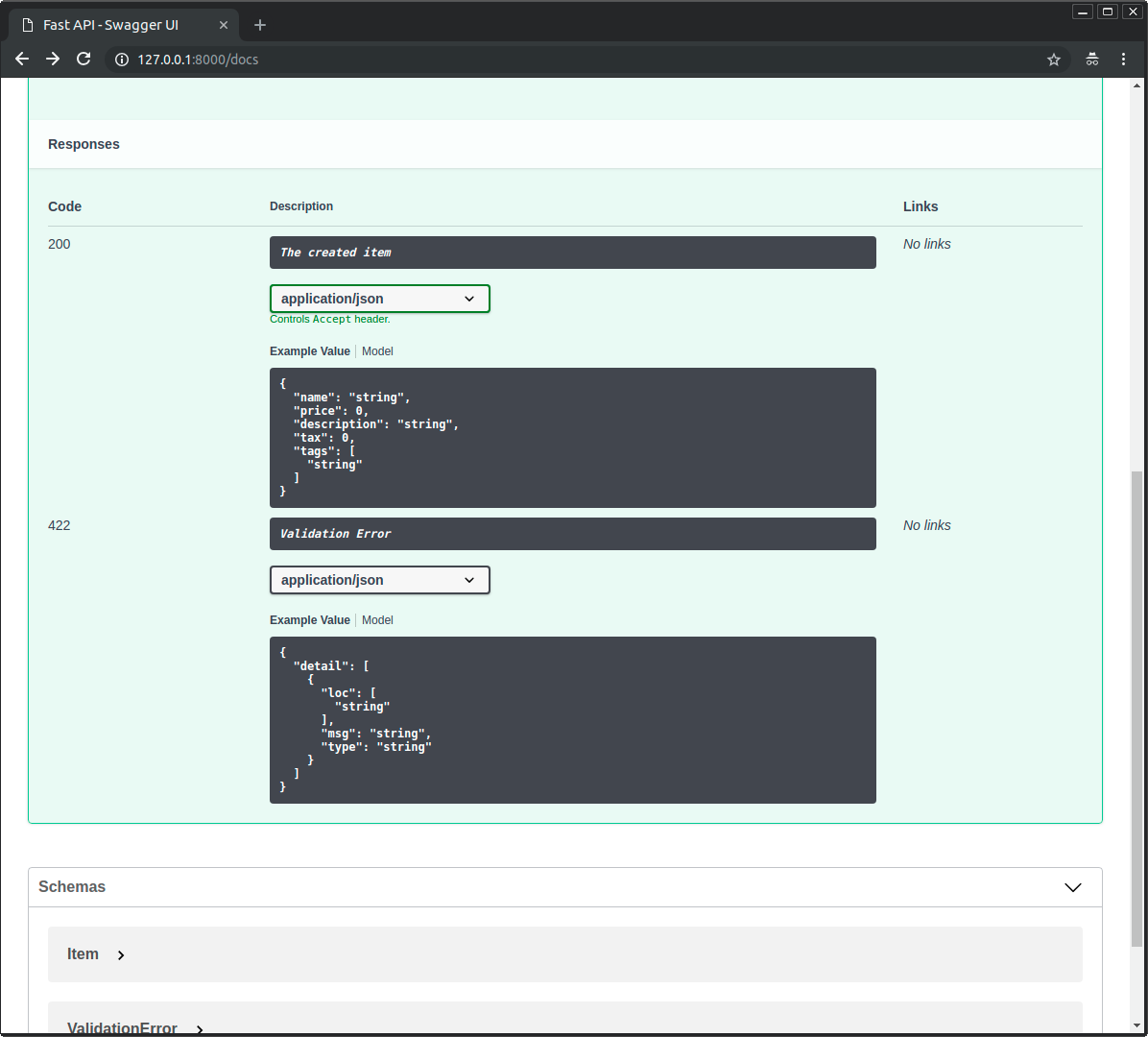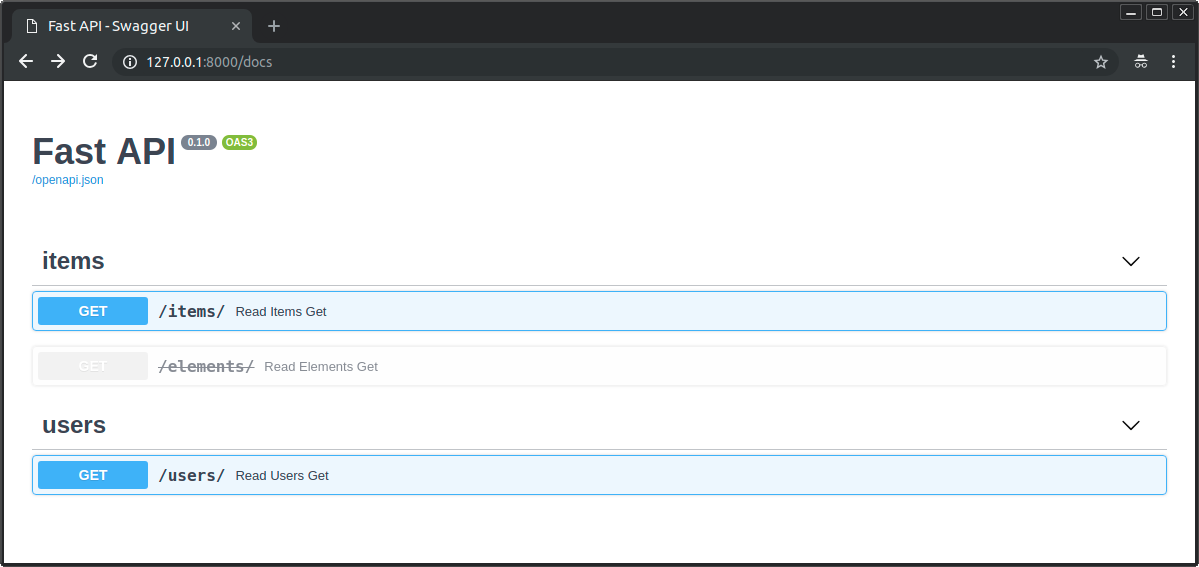路径操作装饰器_支持多种配置参数。
注意:以下参数应直接传递给路径操作装饰器,不能传递给路径操作函数。
status_code 状态码
status_code 用于定义路径操作响应中的 HTTP 状态码。
可以直接传递 int 代码, 比如 404。
如果记不住数字码的涵义,也可以用 status 的快捷常量:
from typing import Set, Unionfrom fastapi import FastAPI, status from pydantic import BaseModelapp = FastAPI()class Item(BaseModel):name: strdescription: Union[str, None] = Noneprice: floattax: Union[float, None] = Nonetags: Set[str] = set()@app.post("/items/", response_model=Item, status_code=status.HTTP_201_CREATED) async def create_item(item: Item):return item
状态码在响应中使用,并会被添加到 OpenAPI 概图。
技术细节
也可以使用 ``` from starlette import status
**FastAPI** 的`fastapi.status` 和 `starlette.status` 一样,只是快捷方式。实际上,`fastapi.status` 直接继承自 Starlette。## `tags` 参数`tags` 参数的值是由 `str` 组成的 `list` (一般只有一个 `str` ),`tags` 用于为_路径操作_添加标签:
from typing import Set, Union
from fastapi import FastAPI from pydantic import BaseModel
app = FastAPI()
class Item(BaseModel): name: str description: Union[str, None] = None price: float tax: Union[float, None] = None tags: Set[str] = set()
@app.post(“/items/“, response_model=Item, tags=[“items”]) async def create_item(item: Item): return item
@app.get(“/items/“, tags=[“items”]) async def read_items(): return [{“name”: “Foo”, “price”: 42}]
@app.get(“/users/“, tags=[“users”]) async def read_users(): return [{“username”: “johndoe”}]
OpenAPI 概图会自动添加标签,供 API 文档接口使用:## `summary` 和 `description` 参数路径装饰器还支持 `summary` 和 `description` 这两个参数:
from typing import Set, Union
from fastapi import FastAPI from pydantic import BaseModel
app = FastAPI()
class Item(BaseModel): name: str description: Union[str, None] = None price: float tax: Union[float, None] = None tags: Set[str] = set()
@app.post( “/items/“, response_model=Item, summary=”Create an item”, description=”Create an item with all the information, name, description, price, tax and a set of unique tags”, ) async def create_item(item: Item): return item
## 文档字符串(`docstring`)描述内容比较长且占用多行时,可以在函数的 docstring 中声明_路径操作_的描述,**FastAPI** 支持从文档字符串中读取描述内容。文档字符串支持 [Markdown](https://en.wikipedia.org/wiki/Markdown),能正确解析和显示 Markdown 的内容,但要注意文档字符串的缩进。
from typing import Set, Union
from fastapi import FastAPI from pydantic import BaseModel
app = FastAPI()
class Item(BaseModel): name: str description: Union[str, None] = None price: float tax: Union[float, None] = None tags: Set[str] = set()
@app.post(“/items/“, response_model=Item, summary=”Create an item”) async def create_item(item: Item): “”” Create an item with all the information: - name: each item must have a name - description: a long description - price: required - tax: if the item doesn’t have tax, you can omit this - tags: a set of unique tag strings for this item “”” return item
下图为 Markdown 文本在 API 文档中的显示效果:## 响应描述`response_description` 参数用于定义响应的描述说明:
from typing import Set, Union
from fastapi import FastAPI from pydantic import BaseModel
app = FastAPI()
class Item(BaseModel): name: str description: Union[str, None] = None price: float tax: Union[float, None] = None tags: Set[str] = set()
@app.post( “/items/“, response_model=Item, summary=”Create an item”, response_description=”The created item”, ) async def create_item(item: Item): “”” Create an item with all the information:
- name: each item must have a name
- description: a long description
- price: required
- tax: if the item doesn’t have tax, you can omit this
- tags: a set of unique tag strings for this item “”” return item ```
说明
注意,response_description 只用于描述响应,description 一般则用于描述路径操作。
检查
OpenAPI 规定每个路径操作都要有响应描述。
如果没有定义响应描述,FastAPI 则自动生成内容为 “Successful response” 的响应描述。

弃用路径操作
deprecated 参数可以把路径操作标记为弃用,无需直接删除:
from fastapi import FastAPIapp = FastAPI()@app.get("/items/", tags=["items"])async def read_items():return [{"name": "Foo", "price": 42}]@app.get("/users/", tags=["users"])async def read_users():return [{"username": "johndoe"}]@app.get("/elements/", tags=["items"], deprecated=True) async def read_elements():return [{"item_id": "Foo"}]
API 文档会把该路径操作标记为弃用:

下图显示了正常路径操作与弃用路径操作 的区别:

小结
通过传递参数给路径操作装饰器 ,即可轻松地配置路径操作、添加元数据。

